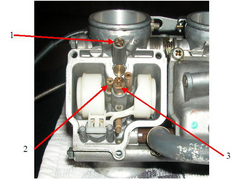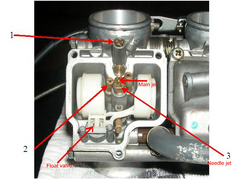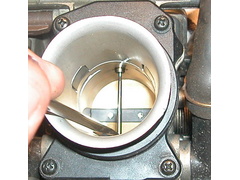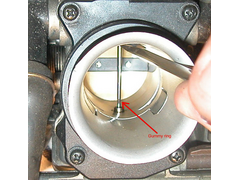chrisf
|
| posted on 30/8/05 at 01:11 AM |

|
|
Carb Cleaning (Follow up to carbs puking)
OK, had a tear down of the carbs this evening. Number 1 in the picture is a mystery. It seems like this is where the carbs leaked initially. Are these
the needle valves? Right now, I can easily turn them from side to side. I only pulled one before I realized it might be the carb balancing screw. Is
this true?
It looks like #2 is the pilot jet. I pulled those and wiped them. They were all pretty clean and I blew through them to make sure there was no
congestion.
#3 looks to me like the main jets. I pulled those and treated them the same as number 2.
Am I doing the proper procedure? Should I let the brass bits soak overnight in something? What should I do with the #1?
--Any help is appreciated, Chris
 
Rescued attachment Question.jpg
|
|
|
|
|
chrisf
|
| posted on 30/8/05 at 01:16 AM |

|
|
What is this? Should I pull it from the rubber diaphram and soak it overnight? I initially pulled one and wiped it down. I didn't really know
what to do with it so I put it back.
EDIT: Well I'd post the pic but the website is having problems. It is the needle looking thing that slides in and out when the black cover an
the carbs moves. This is connected to the rubber diaphram thing...
Again, any help is appreciated.
--Thanks, Chris
[Edited on 30/8/05 by chrisf]
[Edited on 30/8/05 by chrisf]
[Edited on 30/8/05 by chrisf]
|
|
|
Brooky
|
| posted on 30/8/05 at 07:05 AM |

|
|
the big white bulbous things are the floats. These are attached to the needle valves at the bottom left of the picture.
|
|
|
Peteff
|
| posted on 30/8/05 at 09:39 AM |

|
|
1 is the pilot screw to adjust the pilot jet volume. If you've already disturbed it it's too late to worry but if you have one set as per
original try screwing it in till it seats gently and count the turns, then set them to that for a start. The main jet is screwed into the end of the
needle jet. Buy an aerosol of carb cleaner and give it all a good dose. Clean the needle and check it for wear but they usually survive alright. If
it's been stood a long time they get a ring of gum where they are sat in the needle jet and this causes problems. Pull the float pin out and
remove the float to give the valve a dousing with cleaner and work it a few times to loosen it up.
[Edited on 30/8/05 by Peteff]
yours, Pete
I went into the RSPCA office the other day. It was so small you could hardly swing a cat in there.
|
|
|
Peteff
|
| posted on 30/8/05 at 09:53 AM |

|
|
Here
 
Rescued attachment float.jpg
yours, Pete
I went into the RSPCA office the other day. It was so small you could hardly swing a cat in there.
|
|
|
chrisf
|
| posted on 30/8/05 at 01:06 PM |

|
|
Ok, I had a play with the carbs before dashing off to work. I managed to pull the floats and check the float valve. Mine is either covered in rubber
or has a nice amount of buildup. So I'll clean everything this evening and reassemble.
My final question is about the needle. Is this the needle you're talking about? Shall I remove the needle from the piston valve and clean that
well or can this be cleaned without its removal? When I dissassembled last night, I wasn't too keen of removing the diaphram because it seemed
fragile. But if it must be removed...
Thank you all for the help!
--Chris
 
Rescued attachment inside.JPG
|
|
|
Peteff
|
| posted on 30/8/05 at 04:16 PM |

|
|
That's the one.
Get a stiff brush and a rag and clean it where it is. Use the carb cleaner generously. The one I use is a Valvoline product and works well.
 
Rescued attachment inside.JPG
yours, Pete
I went into the RSPCA office the other day. It was so small you could hardly swing a cat in there.
|
|
|













